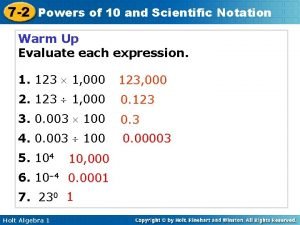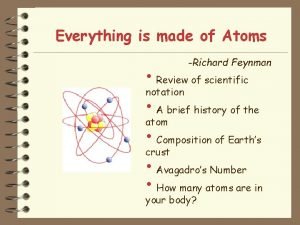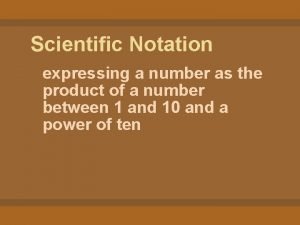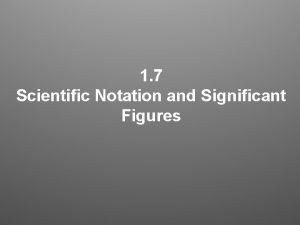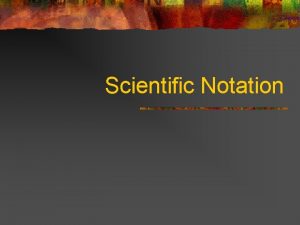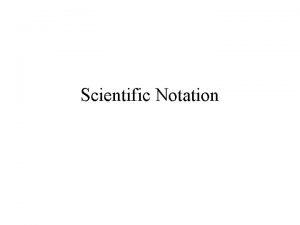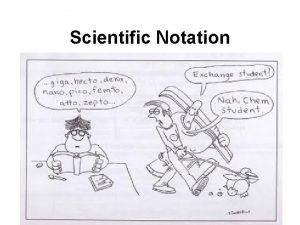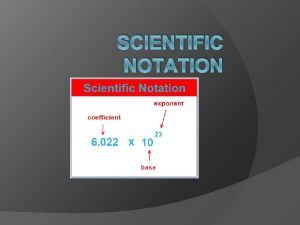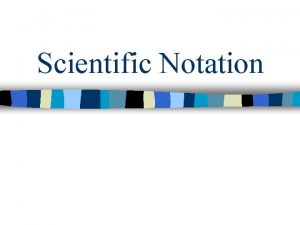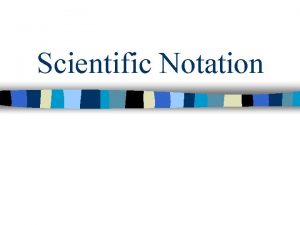SCIENTIFIC NOTATION SCIENTIFIC NOTAION Scientific notation is a








- Slides: 8

SCIENTIFIC NOTATION

SCIENTIFIC NOTAION � Scientific notation is a form of writing large and small numbers without having to include every digit. � It is the way numbers can be abbreviated and written in a shorter form.

CONVERTING TO SCIENTIFIC NOTATION � When you are presented with very large or small values, they can be written in a shorter form. � 4, 500, 000 can be written as 4. 5 x 109. � 0. 0000034 can be written as 3. 4 x 10 -6. � The position of the decimal is moved to have only 1 non-zero to the left. The number of places the decimal moves is written as the exponent on 10.

CONVERTING TO SCIENTIFIC NOTATION � When larger values are written as smaller coefficients, the exponent will be positive (the decimal moved left to make a coefficient). � 1, 200, 000 is 1. 2 x 106 and 350, 000 is 3. 5 x 105. � When smaller values are written as larger coefficients, the exponent will be negative (the decimal moved right to make a coefficient) � 0. 000034 is 3. 4 x 10 -5 and 0. 00079 is 7. 9 x 10 -4.

CONVERTING TO NUMERICAL FORM This is the opposite to writing a value in scientific notation. � When converting to numerical form, if the exponent is positive, the decimal will move right on the coefficient (this make the number larger). � � � 1. 2 x 104 is 12, 000 and 4. 8 x 107 is 48, 000. If the exponent is negative, the decimal will move to the left on the coefficient (this makes the number smaller) � 4. 2 x 10 -4 is 0. 00042 and 5. 9 x 10 -7 is 0. 00000059.

MATH WITH SCIENTIFIC NOTATION When multiplying numbers in scientific notation, you can multiply the coefficients and simply add the exponents. � If you end up with a coefficient that has more than 1 number to the left of the decimal, make adjustments to the coefficient and exponent. � � (3. 5 x 105) x (5. 2 x 107), multiplying 3. 5 and 5. 2 produces 18. 2 and adding 5 to 7 equals 12. Moving the decimal to the left to see 1. 82 will add another 1 to the exponent. The answer is 1. 82 x 1013.

MATH WITH SCIENTIFIC NOTATION � When dividing numbers in scientific notation, you can divide the coefficients and simply subtract the exponents. � If you end up with a coefficient that has more than 1 number to the left or right of the decimal, make adjustments to the coefficient and exponent. � (3. 4 x 104) / (7. 3 x 108), dividing 3. 4 by 7. 3 creates 0. 47 and subtracting 8 from 4 equals -4. Move the decimal on 0. 47 to create 4. 7 and adjust the exponent. The answer would 4. 7 x 10 -5.

MATH WITH SCIENTIFIC NOTATION � When adding or subtracting with scientific notation, the values will need to have the same exponential values to simply add/subtract the coefficients. � (4. 5 x 103) + (5. 7 x 104), you have to adjust the coefficient to have similar exponents. 4. 5 can be changed to 0. 45 to make the exponent 4. Then add/subtract the coefficients and keep the similar exponent. The answer is 6. 15 x 104. Adjustments might be needed to have a proper coefficient.




